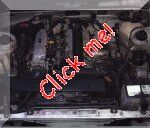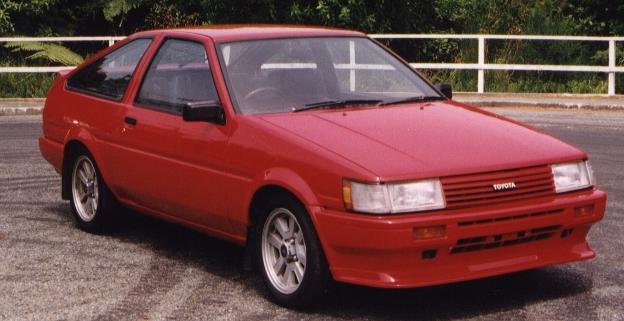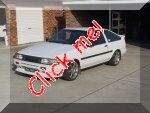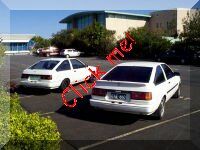
Welcome, from sunny Australia!
More on ...
The Toyota AE-86
Corolla
Performance car on a budget

More on ...
The Toyota AE-86
Corolla
Performance car on a budget
On the drivetrain side of things, they have a 6.7" LSD rear end live axle, with solid disc brakes The diff ratio is usually 4.3:1. It's located by four trailing arms, and laterally by a panhard rod.
| 1st | 3.587:1 |
| 2nd | 2.022:1 |
| 3rd | 1.384:1 |
| 4th | 1:1 |
| 5th | 0.861:1 |
| Rev | 3.484:1 |
| Final drive | 4.30:1 |
The engine is the fabulous 4AGE 1587cc
twin cam 16 valve ... which is basically a copy of the Cosworth BDA
race/rally engine. They share the same bore and stroke - 81mm x 77mm -
and much the same size valves - inlet 29.5mm and exhaust 25.5mm. The
exhaust ports are much the same as the BDA, but the inlet is a lot
bigger, as Toyota use a device called TVIS (Toyota Variable Induction
System) to improve the low to mid range torque. (See my Stock 4AGE page for a full description of the
TVIS device & its operation)
The 4AGE comes in many different types, but
in the RWD version they usually come as a MAP (Manifold Absolute
Pressure) sensor type and so make 130ps, which is ~128hp, or ~96kw. Some
countries has the version that uses an AFM (Air Flow Meter, again, see
my Stock 4AGE page for details) that makes
only about 117hp, 119ps, or 86kw.

| Weight ** | 930kgs |
| Weight balance F/R | 53/47% |
| Length | 4285mm |
| Width | 1625mm |
| Height | 1335mm |
| Wheelbase | 2400mm |
| Track - Front | 1335mm |
| Track - Rear | 1345mm |
| Wheel size | 13" (14" on "GTV" model) |
| Tyre size | 185/70-13 (185/60-14 on "GTV") |
| Brake diameter F & R | 227mm |
| Fuel tank capacity | 50 litres |
| Coefficient of Drag | 0.38 |
| Engine capacity | 1587cc |
| Maximum RPM (redline) | 7700rpm |
| Power | 130ps (~128hp) |
| Torque | 15.2kg-m (109.5ft-lbs) |
Ok, there is a HUGE range of performance
parts available for the AE-86, far too many to even start
listing, in fact. You can modify pretty much any aspect of the car to
whatever standard you wish .... all it takes is $$$! :)
Here's a couple of lightly modified AE-86's.



Mods for the engine are discussed on my Modified 4AGE page, and I talk about how to get
up to about 250hp from the little 1600cc screamer.
Back to the AE-86 intro page
Back to the Index page
Page & contents where applicable © Bill Sherwood